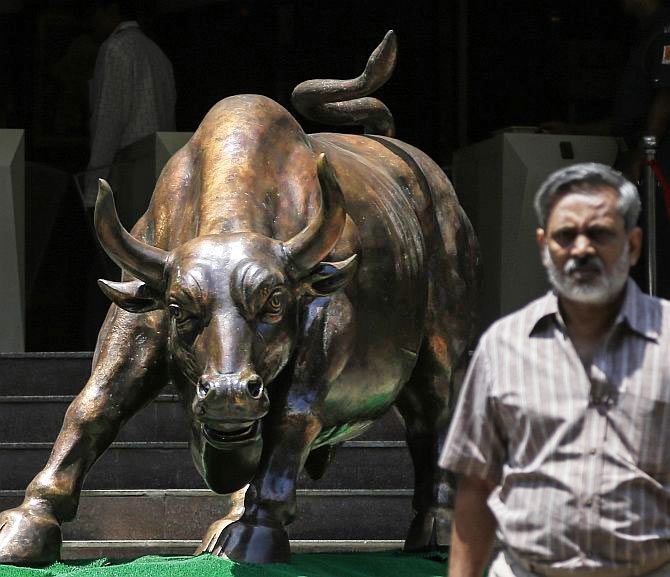There are good reasons to believe that India is at the start of a long period of growth for equities, says Akash Prakash.

A whole series of articles published over the last few months have outlined why equity market returns over the coming years will be far lower than what we have seen in the past 30.
McKinsey, BCA, GMO and many others have produced studies on just this topic.
Returns over the past 34 years have been strong, with the S&P 500 index delivering a compound annual growth rate (CAGR) of 11.5 per cent (from January 1, 1982, to December 31, 2015), despite the bursting of two bubbles.
Returns were truly spectacular between 1982 and 1999, an 18-year period where equities compounded by nearly 19 per cent (CAGR).
All the studies have outlined the unique set of circumstances, and coming together of disparate factors, due to which financial returns were so strong.
Returns were also strong across financial assets, with bonds and equities both doing well. It was a period of truly unprecedented wealth creation.
If one reads these various studies, the reasons cited as to why markets compounded so strongly are the same. The major factors were as follows:
1. Inflation and interest rates were at double-digit levels in the early 1980s; their decline to the low single digits was very bullish for financial assets.
2. Profit margins were low in 1982. As companies restructured, industries deregulated and productivity accelerated, margins surged, supercharging earnings growth.
3. Equity markets were very cheap in 1982, coming off a 14-year bear phase. Valuations rose as rates declined and profits surged.
4. Investor allocations to equities were very low in 1982. Bank deposits offered double-digit returns and equities were perceived as extremely high risk. As interest rates declined, asset allocation shifted into stocks.
5. Households were under-leveraged; thus we had the benefit of strong credit growth, enabling consumption to rise faster than incomes.
6. Demographics were very supportive, both for economic growth and financial savings.
Now maybe I am hallucinating, or just too optimistic, but doesn't the above construct seem similar to where India is today?
This may not be 1982, because valuations are not dirt cheap, but many of the reasons why markets did well are in play for India today.
On inflation and rates, we have transitioned from an economy with double digit inflation to one with inflation at five per cent.
Despite the new inflation-targeting framework in place, markets have not fully accepted that the days of double-digit inflation are in the past.
It is not yet incorporated in valuations or investor thinking. Interest rates will come down further in the coming years as the fisc improves and the RBI's inflation fighting credentials strengthen.
Corporate profitability today is at cyclical lows.
Profits as a share of GDP are below four per cent compared to a cycle average of 6.2 per cent (and a peak of over eight per cent), We have had virtually no corporate profit growth in the past two years.
It is a very reasonable assumption that over the coming years we will have strong reported earnings as GDP accelerates and profit margins normalise.
With capacity utilisation low, and significant cost-cutting and restructuring over the past few years, there is significant operating leverage in the system - any acceleration in GDP will lead to a sharp earnings recovery.
This government has tried to tweak the system. It may be faulted for insufficient ambition in Big Bang reform, but it has done many small things which should boost productivity.
From auctions of natural resources to the ease of doing business to improving infrastructure; from attacking crony capitalism to the surge in start-ups bringing in technology-enabled competition, many steps have been taken to pluck low-hanging fruit.
A surge in productivity will strengthen economic growth and corporate profitability.
Strong productivity growth is the only path to sustainable economic acceleration and we are on the cusp of a productivity surge.
India as a country still has scope to deepen credit penetration, especially among households, small and medium enterprises and in rural and semi- urban India.
We may have over leveraged large business houses, but have the second lowest credit-to-GDP ratio in Asia.
As credit penetration deepens, consumption can grow faster than income growth, underpinning our strong growth outlook. Democratisation of credit is a huge driver for consumption and improving the livelihood of people.
Unlike the West, where the debt super-cycle is over and they are in effect now borrowing consumption from the future, in our economy the willingness and ability to leverage among households and small business still exists.
In the last 18 months we have rediscovered an interest in equities as domestic investors have come back into the asset class.
I feel this is a structural shift into financial assets, linked to demographics, lower inflation and the weakness of property and gold.
Indians are still very underweight on equity; this shift into stocks will continue for many years.
The Indian demographic story is obviously well known, with its positive rub-off for growth, savings, productivity etc.
Valuations are the one area where there is a clear difference. We are not at cheap extremes like one was in 1982 in the US.
At 16 times earnings, we are in the middle of the valuation range for our markets, but these multiples are on depressed earnings.
There is not much scope for a further rerating of multiples from here, but strong earnings should be sufficient to drive market returns.
Falling cost of capital should prevent a multiple fade.
Developed markets in general, but US financial assets in particular, are coming off three decades of strong performance.
Many of those same drivers of performance are visible in India, for our financial markets, as we extend our time horizon.
History may not repeat itself exactly - but it does often rhyme. While it will be bumpy, and not a straight line we may have the best years still ahead of us in terms of financial returns.
India should deliver strong equity returns over the coming five years.
The next six months? Frankly, no one has a clue.
The writer is at Amansa Capital. These views are his own.










